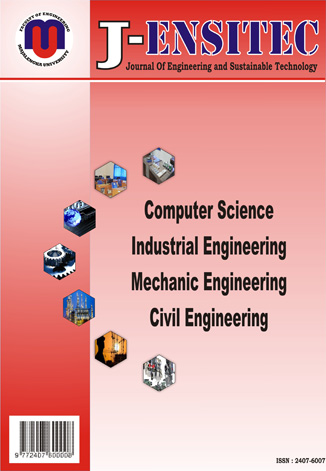ANALISIS SENTIMENT KOMENTAR VIDEO YOUTUBE “EPIC RAP BATTLE OF PRESIDENCY 2024” MENGGUNAKAN ALGORITMA NAÏVE BAYES & SVM
DOI:
https://doi.org/10.31949/jensitec.v10i02.9210Abstract
Sentiment analysis of YouTube video recordings has become important in this increasingly technologically advanced era to understand users' reactions and opinions on various topics, including politics. Rapfight videos, especially those related to the presidential election, are one type of content that often attracts attention. This research uses the Naïve Bayes algorithm to assess the sentiment of comments on the video "Epic Rap Battle of Presidency 2024" on the YouTube site. The algorithms used in this research are Naïve Bayes Classifier and Support Vector Machine (SVM). There are five processes in this research, namely collecting YouTube comment data, preprocessing, labeling, classification, implementation and testing. From 3650 comment data on YouTube regarding the video "Epic Rap Battle of Presidency 2024" based on the results of the analysis, it was found that 31% of the comments were positive, 7% of the comments were negative and 62% of the comments were neutral. The accuracy results using the Naïve Bayes Classifier algorithm were 84.82% and the accuracy results using the Support Vector Machine (SVM) algorithm got the best results at 93.3%.
Keywords:
You Tube Maximum, rapfight, Epic Rap Battle of Presidency 2024, Naïve Bayes, Support Vector Machine(SVM)Downloads
References
A. Rahman, F. Rahmat, M. Y. Fariqi, and S. Adi, “Metode Naive Bayes untuk Menganalisis Akurasi Sentimen Komentar di Youtube,” 2020. [Online]. Available: http://bit.ly/2u802Pe
B. Jie, E. Eric, D. Mervyn, V. Anggrianto, K. Kelvin, and C. Gabriella, “Pemanfaatan Dan Dampak Penggunaan Teknologi Informasi Pada Bidang Sosial,” J. Inf. Syst. Technol., vol. 4, no. 2, pp. 392–397, 2023.
N. Rahmad, D. Setiyawan, D. Novita, R. D. Prasojo, and P. Hukum, “Jurnal SUTASOMA | 37 Tingkat Pemahaman Masyarakat Terhadap Tindak Pidana (Hate Speech, Hoax) Dalam Undang-Undang Informasi Dan Transaksi Elektronik Didesa Pekuncen Kec. Sempor.” [Online]. Available: https://s.id/jurnalsutasoma
C. Oktiawan, “YURIDIS TINDAK PIDANA UJARAN KEBENCIAN DALAM MEDIA SOSIAL.”
M. Arham, “Efektivitas penggunaan youtube sebagai media pembelajaran,” Acad. Educ., vol. 1, no. 1, pp. 1–13, 2020.
A. A. Ratnadewati, “CYBERBULLYING SEBAGAI PELANGGARAN ETIKA KOMUNIKASI DI MEDIA SOSIAL (ANALISIS KUANTITATIF PADA KOLOM KOMENTAR CHANNEL YOUTUBE RICIS OFFICIAL),” 2022.
M. Alhajji, A. Al Khalifah, M. Aljubran, and M. Alkhalifah, “Sentiment analysis of tweets in Saudi Arabia regarding governmental preventive measures to contain COVID-19,” 2020.
K. Fithriasari, R. W. Mayasari, N. Iriawan, and W. S. Winahju, “Surabaya Government Performance Evaluation using Tweet Analysis,” MATEMATIKA, pp. 31–42, 2020.
D. Alita and A. R. Isnain, “Pendeteksian Sarkasme pada Proses Analisis Sentimen Menggunakan Random Forest Classifier,” J. Komputasi, vol. 8, no. 2, pp. 50–58, 2020.
R. P. Tutiasri, N. K. Laminto, and K. Nazri, “Pemanfaatan youtube sebagai media pembelajaran bagi mahasiswa di tengah pandemi covid-19,” J. Komunikasi, Masy. dan Keamanan, vol. 2, no. 2, 2020.
A. Ridwan, “Penerapan Algoritma Naïve Bayes Untuk Klasifikasi Penyakit Diabetes Mellitus,” J. SISKOM-KB (Sistem Komput. dan Kecerdasan Buatan), vol. 4, no. 1, pp. 15–21, 2020.
A. Rahman Isnain, A. Indra Sakti, D. Alita, and N. Satya Marga, “SENTIMEN ANALISIS PUBLIK TERHADAP KEBIJAKAN LOCKDOWN PEMERINTAH JAKARTA MENGGUNAKAN ALGORITMA SVM,” JDMSI, vol. 2, no. 1, pp. 31–37, 2021, [Online]. Available: https://t.co/NfhnfMjtXw
M. H. Asnawi, “Perbandingan Algoritma Naïve Bayes, K-NN, dan SVM dalam Pengklasifikasian Sentimen Media Sosial”, doi: 10.1234/pns.v10i.85.
T. Aura Azzahra et al., “JURNAL MEDIA INFORMATIKA BUDIDARMA Perbandingan Efektivitas Naïve Bayes dan SVM dalam Menganalisis Sentimen Kebencanaan di Youtube,” 2024, doi: 10.30865/mib.v8i1.7186.
D. Mualfah, R. Gunawan, and D. M. Suratno, “Analisis Sentimen Komentar YouTube TvOne Tentang Ustadz Abdul Somad Dideportasi Dari Singapura Menggunakan Algoritma SVM,” J. FASILKOM, vol. 13, no. 01, pp. 72–80, 2023.
M. Hudha, E. Supriyati, and T. Listyorini, “ANALISIS SENTIMEN PENGGUNA YOUTUBE TERHADAP TAYANGAN# MATANAJWAMENANTITERAWAN DENGAN METODE NAÃ VE BAYES CLASSIFIER,” JIKO (Jurnal Inform. dan Komputer), vol. 5, no. 1, pp. 1–6, 2022.
E. F. Saputra and M. R. Pribadi, “Analisis Sentimen Komentar Pada Kanal Youtube The Lazy Monday Menggunakan Algoritma Naive Bayes,” in MDP Student Conference, 2023, vol. 2, no. 1, pp. 17–23.
L. Lumbaa, “Implementasi Metode SVM dan Gardiant Boost Dalam Kalsifikasi Bahasa Daerah,” JATISI (Jurnal Tek. Inform. dan Sist. Informasi), vol. 9, no. 2, pp. 908–915, 2022.
Endar Setyoroso, & Ismail. (2023). DESAIN UI/UX SISTEM INFORMASI MANAJEMEN MASYARAKAT TINGKAT RT BERBASIS WEB UNTUK MEMINIMALISIR MASALAH SOSIAL. J-ENSITEC (Journal of Engineering and Sustainable Technology), 10(01), 883–891.
Published
How to Cite
Issue
Section
License
Copyright (c) 2024 Gavin Berylian Josepto, Rafif Dhia Yusrana, Marvin Donald Richardo Aronggear, Viktor Handrianus Pranatawijaya, Ressa Priskila

This work is licensed under a Creative Commons Attribution-ShareAlike 4.0 International License.
An author who publishes in the J-ENSITEC (Journal of Engineering and Sustainable Technology) agrees to the following terms:
- Author retains the copyright and grants the journal the right of first publication of the work simultaneously licensed under the Creative Commons Attribution-ShareAlike 4.0 License that allows others to share the work with an acknowledgment of the work's authorship and initial publication in this journal
- The author is able to enter into separate, additional contractual arrangements for the non-exclusive distribution of the journal's published version of the work (e.g., post it to an institutional repository or publish it in a book) with the acknowledgment of its initial publication in this journal.
- The author is permitted and encouraged to post his/her work online (e.g., in institutional repositories or on their website) prior to and during the submission process, as it can lead to productive exchanges, as well as earlier and greater citation of the published work







